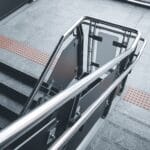Installing a stainless steel guardrail is an investment that combines aesthetics and robustness. Thanks to its natural resistance to corrosion and its contemporary look, it fits just as well in residential spaces as in professional ones. At Metanox, we use only high-quality stainless steel, suited to the environment in which it will be installed. However, even the best materials require proper maintenance to preserve their appearance and performance.
Regular, appropriate cleaning is more than an aesthetic gesture: it also helps extend the life of the installation by preserving its natural protective layer. This guide presents best practices for cleaning a stainless steel guardrail according to its type, its location, and the safest products.
Key takeaways
- Choosing stainless steel suited to the environment is the first step toward successful maintenance.
- Avoid harsh products and tools to prevent damaging the surface.
- Clean regularly with warm soapy water, then rinse and dry.
- Adjust the cleaning frequency based on exposure to weather or sea spray.
- Use a protective product to reduce the adherence of dirt.
Why choose stainless steel for your guardrails
Strength and longevity
Stainless steel is known for its resistance to mechanical stress, impacts, and corrosion. Unlike wood, which requires regular treatment, or painted steel, which can flake, stainless steel retains its properties without the need for an additional protective coating. This makes it a preferred choice for guardrails, which are subjected to daily use and must remain reliable over the years.
For outdoor installations, especially in areas highly exposed to wind and weather, stainless steel offers enhanced safety because it does not deform or weaken, even after years of use. The models offered by Metanox are designed to provide this durability while maintaining a flawless appearance with minimal maintenance.
Aesthetics and adaptability
Beyond its technical performance, stainless steel stands out for its elegant, timeless look. Brushed finishes offer a matte appearance that masks minor marks, while mirror-polished finishes provide sophisticated shine, ideal for high-end locations or spaces with strong light exposure. This aesthetic adaptability allows Metanox to offer guardrails that integrate perfectly with any architectural style, from contemporary design to more traditional architecture.
Types of stainless steel used for guardrails
The choice of stainless steel should always be based on location and exposure to corrosive agents. A poorly chosen grade may require heavier maintenance or even deteriorate prematurely.
| Stainless steel type | Recommended use | Corrosion resistance | Example application |
| 304 brushed stainless | Indoors only | Good, but sensitive to humid or saline environments | Indoor stairs, mezzanines |
| 316 brushed stainless | Outdoors, outside marine areas | Very good, withstands rain and humidity | Terraces, balconies |
| 316 mirror-polished stainless | Outdoors in marine environments or by a pool | Excellent, resists salt and chlorine | Seaside guardrails, poolside areas |
Technical note
Thanks to the addition of molybdenum, 316 stainless steel has better corrosion resistance than 304 stainless steel. Although this difference is subtle to the naked eye, it is crucial in a harsh environment. At Metanox, we systematically recommend 316 mirror-polished stainless for marine areas, as the mirror finish further reduces the adherence of saline particles and makes cleaning easier.
Mistakes to avoid when cleaning stainless steel
Products to avoid
Stainless steel benefits from a passive protective layer of chromium oxide that makes it corrosion-resistant. Acidic products, descalers, or bleach can damage this layer and leave the surface vulnerable. Once the protective layer is compromised, corrosion stains can appear even on high-quality stainless steel.
Also avoid chlorine-based cleaners, often used in environments near pools, as repeated use can lead to pitting corrosion that is initially invisible but difficult to remove later.
Techniques to avoid
Abrasive tools, such as metal scouring pads or stiff brushes, can scratch the surface and harm its appearance. Even small scratches can become areas where dirt and moisture accumulate, increasing the risk of staining. It’s best to use only soft cloths or non-abrasive sponges, and always rub in the direction of the brushing to preserve the finish.
Ideal cleaning frequency
| Environment | Recommended frequency | Main method |
| Indoors (304 stainless) | Weekly | Microfibre cloth and soapy water |
| Outdoors (316 stainless) | Every 4 to 6 months | Soapy water, rinse and dry |
| Marine or pool environment (316 mirror-polished stainless) | Every 2 to 4 months or after salt spray | Rinse with clean water and apply protective spray |
Adjusting to exposure
In polluted urban settings or very dusty areas, the cleaning frequency should be increased. Regular visual checks allow you to act before deposits become ingrained. At Metanox, we advise clients to schedule more frequent cleaning during wet seasons or after a major weather event.
Best practices for cleaning a stainless steel guardrail
Routine cleaning
For regular cleaning, warm water and mild soap are ideal. Applying the solution with a microfibre cloth removes dirt without attacking the surface. A thorough rinse with clean water is essential to avoid residue marks, followed by careful drying to prevent water spots left by evaporation.
Targeted stain removal
Grease stains can be effectively removed with diluted baking soda or flour, which acts as an absorbent. Brownish marks can be cleaned with a cloth soaked in rubbing alcohol or a light layer of vegetable oil, which temporarily restores shine. The rare traces of rust can be eliminated with a specialized product, taking care not to overuse it so as not to affect the finish.
Preserving the shine
Applying a stainless steel polish or protective spray every six months helps reduce the adherence of water and dust. This extra protection extends the interval between cleanings and makes maintenance easier.
Recommended maintenance products
Natural solutions
Baking soda is effective at removing deposits without causing micro-scratches, while Marseille soap cleans deeply while respecting the surface. These solutions are perfect for regular household use.
Specialized products
For more spaced-out maintenance, especially on hard-to-reach installations, protective sprays for stainless steel are recommended. They leave an invisible film that repels water and limits dust accumulation. Professional-grade products available from hardware stores or specialized suppliers provide optimal protection suited to the stainless steel used by Metanox.
Special case: guardrails in marine environments
Impact of salt spray
Salty air is one of the most corrosive environments for stainless steel. Even marine-grade stainless will wear faster without regular maintenance. When saline particles dry on the surface, they can leave white deposits or brownish stains.
Specific maintenance
Frequent rinsing with clean water helps dissolve salts before they become embedded. After rinsing, it’s best to dry the surface to avoid water marks. Applying marine-grade protective products twice a year strengthens the passive layer and limits particle adherence.
Conclusion: sustainably preserving your guardrail’s shine
Maintaining a quality stainless steel guardrail, like those supplied by Metanox, doesn’t require special skills, but it does require regularity and care. By using suitable products, avoiding aggressive methods, and respecting the recommended cleaning frequency, you ensure optimal longevity and a flawless appearance for your installation.
















